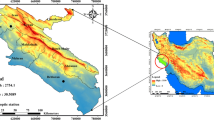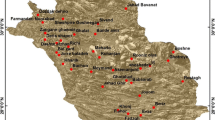Abstract
Drought is one of the most important natural hazards in Iran. It is especially more prevalent in arid and hyper arid regions where there are serious limitations in regard to providing sufficient water resources. On the other hand, drought modeling and particularly its prediction can play important role in water resources management under conditions of lack of sufficient water resources. Therefore, in this study, drought prediction in a hyper arid location of Iran (Ardakan region) has been surveyed based on the abilities of artificial neural. Standardized Precipitation Index (SPI) in different time scales (3, 6, 9, 12, and 24 monthly time series) computed based on the data gathered from four rain gauge stations. After evaluation and testing of different artificial neural networks (ANN) structures, gradient descent back propagation (traingd) network showed higher abilities than others. Then, the predictions of SPI time series with different monthly lag times (1:12 months) were tested. Generally, drought prediction by ANNs in the Ardakan region has shown considerable results with the correlation coefficient (R) more than 0.79 and in the most cases and it rises more than 0.90, which indicates the ANN’s ability of drought prediction.


















Similar content being viewed by others
References
Abramowitz M, Stegun A (1965) Handbook of mathematical formulas, graphs, and mathematical tables. Dover, New York
Bordi I, Sutera A (2002) An analysis of drought in Italy in the last fifty years. Nuovo Cimento 025(2):185–206
Cybenko G (1989) Approximation by superpositions of a sigmoidal function. Math Contr Signals Syst 2(4):303–314
Dastorani MT, Afkhami H (2011) Application of artificial neural networks on drought prediction in Yazd (Central Iran). Desert Journal 16:39–48
Edwards D, McKee T (1997) Characteristics of 20th century drought in the United States at multiple timescales. 97–2. Colorado State University Fort Collins, Climatology Report
Erol Keskin M, Terzi Ö (2006) Artificial neural network models of daily pan evaporation. Hydrologic Engrg 11(1):65–70
Fletcher D, Goss E (1993) Forecasting with neural networks: an application using bankruptcy data. Info Manage 24:59–167
Gabriel KR, Neumann J (1962) A Markov chain model for daily rainfall occurrences at Tel Aviv. Q J R Meteorol Soc 88:90–95
Govindaraju RS (2000) Artificial neural networks in hydrology. II: hydrologic applications. J Hydrologic Engrg 5(2):124–137
Hecht-Nielsen R (1990) Neurocomputing. Addison-Wesley, Menlo Park
Hornik K, Stinchcombe M, White H (1989) Multilayer feedforward networks are universal approximators. Neural Netw 25(5):359–366
Hughes B, Saunders M (2002) A drought climatology for Europe. Int J Climatol 22:1571–1592
Lippmann RP (1987) An introduction to computing with neural nets. IEEE ASSP Mag 4(2):4–22
Maier HR, Dandy GC (1996) The use of artificial neural networks for the prediction of water quality parameters. Water Resour Res 32(4):1013–1022
Marzban C, Stumpf GJ (1996) A neural network for tornado and/or severe weather prediction based on Doppler Radar-derived attributes 10th Annual Mid-American Symposium on Emerging Computer Technologies, University of Oklahoma, October 28–29
McKee T, Doesken N, Kleist J (1993) The relationship of drought frequency and duration to time scales, 8th conference on applied climatology, Anaheim,CA, Am Meteor Soc, Boston, pp 179–184
Mishra AK, Desai VR (2005a) Drought forecasting using stochastic models. Stoch Environ Res Risk Assessment 19:326–339
Mishra AK, Desai VR (2005b) Spatial and temporal drought analysis in the Kansabati River Basin, India. Int J River Basin Management 3(1):31–41
Mishra AK, Desai VR (2006) Drought forecasting using feed-forward recursive neural network. Ecol Model 198:127–138
Mishra AK, Singh VP (2009) Analysis of drought severity-area-frequency curves using a general circulation model and scenario uncertainty. J Geophys Res 114:D06120. doi:10.1029/2008JD010986
Mishra AK, Singh VP (2010) A review of drought concepts. J Hydrol 391(1–2):202–216
Mishra AK, Singh VP (2011) Drought modeling—a review. J Hydrol 403(1–2):157–175
Mishra AK, Desai VR, Singh VP (2007) Drought forecasting using a hybrid stochastic and neural network model. J Hydrolog Eng ASCE 12(6):626–638
Mishra AK, Singh VP, Desai VR (2009) Drought characterization: a probabilistic approach. Stoch Environ Res Risk Assess 23(1):41–55
Morid S, Smakhtin S, Moghaddasi M (2006) Comparison of seven meteorological indices for drought monitoring in Iran. Int J Climatol 26:971–985
Morid S, Smakhtin V, Bagherzadeh K (2007) Drought forecasting using artificial neural networks and time series of drought indices. Int J Climatol 27:2103–2111
Palmer W (1965) Meteorological drought, U.S. Department of Commerce Weather Bureau Research, Washington, DC
Panu US, Sharma TC (2002) Challenges in drought research: some perspectives and future directions. Hydrol Sci J 47:19–30
Rahimi Khoob A (2007) Comparative study of Hargreaves’s and artificial neural network’s methodologies in estimating reference evapotranspiration in a semiarid environment. Irrig Sci 26(3):253–259
Rahimi Khoob A (2008) Artificial neural network estimation of reference evapotranspiration from pan evaporation in a semi-arid environment. Irrig Sci 27(1):35–39
Rahnama MB, Noury M (2008) Developing of Halil River rainfall-runoff model, using conjunction of wavelet transform and artificial neural networks. Res J Environ Sci 2(5):385–392
Tang Z, Fishwick PA (1993) Feedforward neural nets as models for time series forecasting. ORSA J Comput 5(4):374–385
Thom H (1958) A note on gamma distribution. Monthly Weather Rev 86:117–122
Torranin P (1976) Unpredictability of hydrological drought. In: Proceeding of the Second International Symposium in Hydrology, Fort Collins, Colorado, 595–604
Win Mar K, Thu Naing T (2008) Optimum neural network architecture for precipitation prediction of Myanmar. World Academy of Science, Engineering and Technology 48
Wong FS (1991) Time series forecasting using back propagation neural networks. Neurocomputing 2:147–159
Woong Kim T (2008) Monthly precipitation forecasting using rescaling errors. KSCE J Civ Eng 10(2):137–143
Woong Kim T, Valdés JB (2003) A nonlinear model for drought forecasting based on conjunction of wavelet transforms and neural networks. ASCE J Hydrolog Eng 8:319–328
Wu H, Svoboda M, Hayes M, Wilhite D, Wen F (2007) ppropriate application of the Standardized Precipitation Index in arid locations and dry seasons. Int J Climatol 27:65–79
Zhai L, Feng Q (2008) Spatial and temporal pattern of precipitation and drought in Gansu Province, Northwest China. Nat Hazards 49(1):1–24
Zhang BL, Dong ZY (2001) An adaptive neural-wavelet model for short term load forecasting. Electric Power Syst Res 59:121–129
Acknowledgments
Data used in this study were made available by the Iranian Meteorological Organization. The authors greatly acknowledge the Payame Noor University, Yazd, Iran for providing the financial support for the present study. Furthermore, authors greatly appreciate the technical support of the Management Center for Strategic Projects in Fars Organization Centre of Jahad-Agriculture of Iran.
Author information
Authors and Affiliations
Corresponding author
Rights and permissions
About this article
Cite this article
Bari Abarghouei, H., Kousari, M.R. & Asadi Zarch, M.A. Prediction of drought in dry lands through feedforward artificial neural network abilities. Arab J Geosci 6, 1417–1433 (2013). https://doi.org/10.1007/s12517-011-0445-x
Received:
Accepted:
Published:
Issue Date:
DOI: https://doi.org/10.1007/s12517-011-0445-x




